America’s Middle-class Meltdown: Core shrinks to half of US homes
Roula Khalaf, Editor of the FT, selects her favourite stories in this weekly newsletter.
America’s middle class has shrunk to just half the population for the first time in at least four decades as the forces of technological change and globalisation drive a wedge between the winners and losers in a splintering US society.
The ranks of the middle class are now narrowly outnumbered by those in lower and upper income strata combined for the first time since at least the early 1970s, according to the definitions by the Pew Research Center, a non-partisan think-tank in research shared with the Financial Times.
The findings come amid an intensifying debate leading up to next year’s presidential election over how to revive the fortunes of the US middle class.
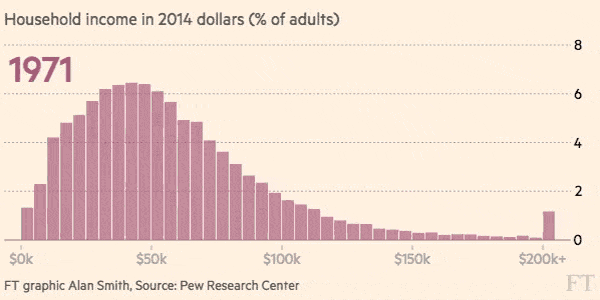
The prevailing view that the middle class is being crushed is helping to feed some of the popular anger that has boosted the populist politics personified by Donald Trump’s candidacy for the Republican presidential nomination. “The middle class is disappearing,” says Alison Fuller, a 25-year-old university graduate working for a medical start-up in Smyrna, Georgia, who sees herself voting for Mr Trump.
Pew used one of the broadest income classifications of the middle class, in a new analysis detailing the “hollowing out” of a group that has formed the bedrock of America’s postwar success.
The core of American society now represents 50 per cent or less of the adult population, compared with 61 per cent at the end of the 1960s. Strikingly, the change has been driven at least as much by rapid growth in the ranks of prosperous Americans above the level of the middle class as it has by expansion in the numbers of poorer citizens.
Jason Furman, chairman of President Barack Obama’s Council of Economic Advisers, says: “You have seen a hollowing out of the middle of the income distribution, and there’s neither one cause for it nor a single answer. It’s a big problem, it is decades in the making, and it will require a lot of solutions.”
Recent political debate has been dominated by the view that US society has been distorted by staggering gains for the top 1 per cent of the country at the expense of the remaining 99 per cent.
Pew’s research gives a more nuanced picture however. Better off households — defined by Pew as earning more than $125,608 a year — account for more than one-in-five of the US population. That is the highest share the study has found, as well-educated Americans from finance to computer programming and biotech enjoy strong prospects. “On balance, there is more economic progress than regression,” the report says.
But the campaign of Mr Trump, the real estate tycoon, has fed off concerns at the other end of the scale. The Fullers have a three-bedroom home but about $100,000 in student debt. While Ms Fuller is uneasy with some of Mr Trump’s policies, she says she thought “Trump overall would be good for this nation,” arguing he is likely to reduce the tax burden on the middle class.
While Democrats and Republicans have vowed to revive the middle class, they have not settled on the term’s meaning. Pew divides the population into two lower groups, the middle, and two upper tiers. Pew defined the middle as being a household income from two-thirds to double the median. For a three-person family, that is $41,869 to $125,608 a year.
Since 2008, the number of adults in households in the upper two tiers has grown by 7.8m, outpacing the growth in the number of adults in households in the lower two tiers, where the number of people grew by 6.8m. The middle class grew by 3m over the same period.
The research also tracks different demographic groups to find the winners and losers in recent decades. Older Americans were the biggest gainers by far in terms of their progression up the income tiers during the current century, and also when compared with the start of the 1970s, it finds. The group aged 18-29 has seen the biggest slide.
A key factor driving the wedge between successful Americans and those who are struggling is the outsized premium the labour market places on skills and higher education. College graduates are eight times likelier to live in the upper income tiers than adults who did not finish high school, and twice as likely as an adult who has only a high school diploma, Pew finds.
“Those Americans without a college degree stand out as experiencing a substantial loss in economic status,” the report says.
David Autor, a professor at Massachusetts Institute of Technology, has found that the earnings gap between the median college-educated US male and the median male with a high school education doubled between 1979 and 2012, underscoring the mounting premium placed on educational achievement.
“There hasn’t been a lot of wage growth, but it is still the case that the return on educational investments is incredibly high for people who go to reasonable colleges and complete them,” he says.
Focusing entirely on the disparity between the top 1 per cent and the 99 per cent is therefore misleading. “It gives people the wrong message that if you are not Mark Zuckerberg or Bernie Madoff you are kind of out of the game,” Mr Autor adds. “That is not correct.”
The sense of polarisation in US society is underscored by the rapid growth seen at the extreme rich and poor ends of the spectrum. “The distribution of adults by income is thinning in the middle and bulking up at the edges,” says Pew’s report. Households above the middle class are on the cusp of holding more income than all other households combined, suggesting earnings are getting concentrated in fewer hands.
Upper income Americans more than doubled their wealth gap against the middle from three times as much to seven times, according to the report.
Pew’s data, which draw on official numbers, adjust for inflation and put everyone in a three-person household to make figures more comparable. Their research finds that the hollowing of the American middle has been under way steadily since the 1970s, rather than being a sudden phenomenon that emerged recently.
The FT interviewed Americans around the US to hear their views on the state of the middle class and their place in it. Their comments range from the insecurity felt by public sector workers, whose numbers were cut sharply after the Great Recession, to the optimism of high-tech workers who have been among the big winners in a jobs market that prizes skills and high educational attainment.
Together, they represent a society that is looking increasingly fractured.
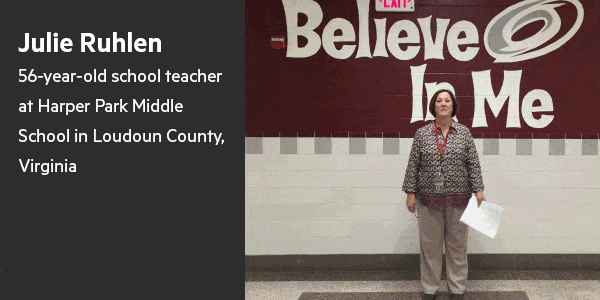
Julie Ruhlen works in one of the wealthiest counties of the US, but she says the idea of living there is out of her reach.
Ms Ruhlen is a state school teacher at Harper Park Middle School in Loudoun County, Virginia, a leafy suburb dotted with multimillion dollar mansions that is one of the richest localities in the US.
Podcast
What happens after rates rise, the shrinking middle class and pay equity

Economists widely agree that Janet Yellen and the Fed board will lift interest rates at the December 16 meeting but expectations vary just as much when it comes to longer term monetary policy. Capital markets correspondent Eric Platt joins Shannon Bond to discuss. Then, a shrinking in America’s middle class to less than 50 per cent of the population for the first time since the early 1970s comes under examination from Washington-based FT correspondents Sam Fleming and Shawn Donnan. Finally, economist Claudia Goldin explains a theory about narrowing the gender pay gap in certain occupations. Music by Salmo and Kevin MacLeod.
Like many public school teachers, however, she has to supplement her income with a part-time job — in her case, working at one of the state’s wineries — to maintain the lifestyle she wants.
Teachers have been among the poorest performers in terms of income mobility since the 1970s. Among the 14 professions tracked by Pew between 2001 and 2014 they have suffered the biggest slide down the income ladder as states have slashed budgets, resulting in stalled wages or job cuts for a broad range of middle-class public sector workers.
“It is not just affecting me personally but also the people I am out there to help,” said Ms Ruhlen, who commutes 50 minutes each way to work. “I could do so much more if I were able to live in the community where I teach.”
Incomes for teachers vary sharply depending on where they work, and Pew’s data suggest that the profession still has more members of the upper and middle tier than the employed population as a whole.
Still, belt-tightening among many in the US has left a shortage of 375,000 public school teachers, according to estimates by The Economic Policy Institute, a left-leaning think-tank.
Nationwide, public school teachers’ salaries were 3.5 per cent lower in 2013-14 than a decade earlier, in real terms, according to the National Education Association. In Virginia, teachers have seen a 2.8 per cent decline since 2003-04, it said in a report this year. The average Virginia classroom teacher earned $49,826, below the national average of $56,610.
“I don’t consider myself middle class,” said Tina Williams, a school counsellor based in Fairfax, Virginia, who has a part-time job working in a department store. “I remember [when I was] growing up the teachers who educated me seemed to live a lot more comfortably than I do.”
Sam Fleming in Loudoun County, Virginia
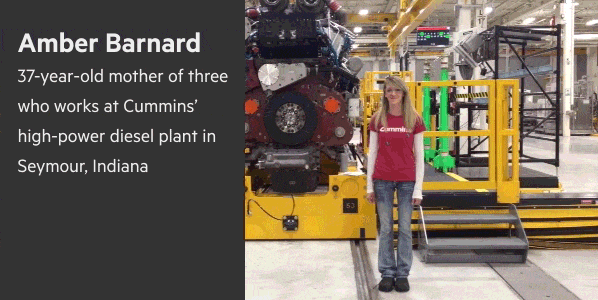
Amid the long slow decline of America’s manufacturing sector, it looked like blue-collar jobs such as Amber Barnard’s would soon be a thing of the past.
But things are looking up for the mother of three. After 11 years working on an assembly line in Seymour, Indiana, she is seeing her wages rise and her skills improve.
She was recently promoted, received an increase to $20.75 an hour, which brings her salary to about $43,000 per annum before overtime, and her company is paying for her to attend university-level business courses.
The Cummins diesel engine plant where she works has been in town for decades. But in the past five years it has had a $300m upgrade and a new 95-litre engine is being launched. What was once an ageing plant with an unproductive workforce is a model of modern manufacturing.
Seymour displays evidence of a town on the rebound. Cummins opened a research facility adjacent to a plant that employs 400 engineers, and other groups are also expanding.
“Everybody around me seems to be . . . making more money,” says Ms Barnard. “Everybody is growing and businesses are doing well.”
It helps that her husband is holding down an equally good job at a Toyota forklift plant nearby. But the lives they live now are materially different than they were during the recession. Three years ago, they bought a house four blocks from the Cummins plant. Two years ago, they went to Myrtle Beach in South Carolina for a family holiday. This year they are planning a road trip out west to tour Yellowstone and other national parks.
The American middle class is not as blue collar as it once was. In 1971, 28 per cent of adults in middle-income households were in manufacturing. Today that figure is 11 per cent. But those who have managed to hang on to jobs in manufacturing remain an important part of the middle class, even as some predict factory jobs may be affected by a fresh wave of automation.
Cummins’ Seymour plant uses robots but Tom Linebarger, the company’s chief executive, sees a limited role for them in factories that make highly customised products. The flexibility of Seymour’s labour force is one of the keys to its success. “It costs you a lot to get flexibility with robots,” Mr Linebarger says.
Even in tough times the factory jobs look safer than in the past. When Cummins announced lay-offs this year to cope with a downturn, it found ways to cut hours and keep more staff on board.
Those jobs that went were from Cummins’ professional ranks rather than the factory floor.
For now, at least, Ms Barnard’s place in the middle class appears safe.
Shawn Donnan in Seymour, Indiana

Liz Heath has been waiting for five years but work is finally under way on the renovation that will more than double the size of her 1927 bungalow in Atlanta’s gentrifying Grant Park neighbourhood.
It helps that Ms Heath is an architect and drew the plans for the 3,100-square-foot renovation herself. But beyond fulfilling a long-held goal, her project is a sign of renewed confidence. After starting her career in the shadow of the 2008-09 recession, Ms Heath senses that she and her peers are living in a more hopeful economy.
“We came out of school and after a few years we hit a point where we were earning less than we did out of school,” she says. “But since then things have started moving forward. We are feeding back in to the economy.”
Ms Heath has been the beneficiary of a boom in professional services, such as architecture, that has yielded what is now a much more white collar middle class.
In 1971, 18 per cent of the American middle class worked in business and professional services; today, one-third of it does. Almost one in three of the 66,000 jobs that the Atlanta area added in the year to August were in business and professional services.
That pattern holds true nationally, with business and professional services representing the fastest-growing segment of the labour force over the past year. Of the 2.9m jobs the US added in the year to August, more than 650,000 were in these services, or almost six times as many as the new jobs added in manufacturing.
That growth is reflected at tvsdesign, Ms Heath’s firm, which has built a niche in designing convention centres and has half a dozen projects in China alone. After laying off staff in the wake of the 2008 financial crisis it has been hiring again and now has about 150 people on its books.
It also poses new problems for cities like Atlanta.
After years of weathering a slow economy the big challenge confronting Atlanta, says Tom Cunningham, chief economist for the Metro Atlanta Chamber of Commerce, is attracting skilled workers.
“We have had much more steady immigration of jobs than people,” Mr Cunningham says.
Shawn Donnan in Atlanta
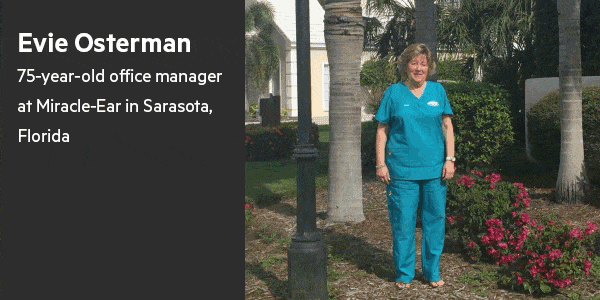
After spending a few years living “a nice retired-lady life”, Evie Osterman, 75, decided it was time to return to work. She is the full-time office manager at Miracle Ear and spends her days speaking in a loud, clear voice to potential clients and helping customers handle glitches in their hearing aids.
“Let’s face it, you retire thinking you have enough money, but here’s the big variable. No one knows how long you are going to live,” she says, sitting in a small neat office. While she and her husband could get by without her working, they would have to cut back, she says.
“It is hard for people in the middle class today to be able to survive. Life gets more and more expensive.”
While people over 65 have made the greatest strides up the income ladder since the early 1970s, statistics suggest more retirement-age Americans are seeking work. The 65 and over demographic is the only group that has seen an increase in its job participation rate since the start of the decade.
Projections from the McKinsey Global Institute suggest that between 2015 and 2030, no less than half of consumer spending growth will be driven by people aged 60 and above. For a vision of future trends, policymakers could do worse than visiting Sarasota County, Florida, a seaside retirement community with a median age of more than 53, as opposed to the national level of 37.
Many spend their days playing mah-jong and bridge but not everyone does.
“It’s not a struggle but we have to watch our nickels and dimes. Luckily this part-time job does help me meet our expenses,” said Norman Gassman, a former shoe-store owner who is a visitor guide in a mall. While the poverty rate among those 65 and older fell to 10 per cent last year compared with nearly 25 per cent in the 1970s, members of this demographic are more likely to be lower income than any other age group.
Rising medical costs, longer lifespans and squeezed retirement benefits will add to pressure on senior citizens and the public purse in decades to come.
Sam Fleming in Sarasota, Florida
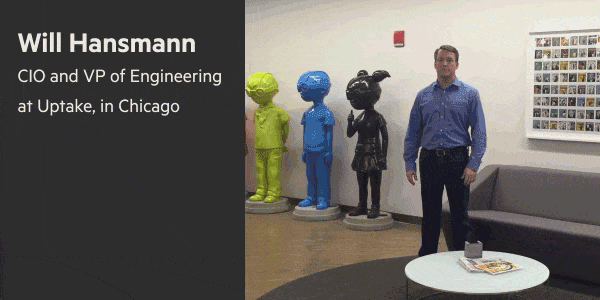
The son of computer scientists, Will Hansmann remembers being taught the BASIC computer language by his mother while still in elementary school. By the time he was seven, he was disassembling mainframes that his father brought home from work.
His childhood served him well. He now oversees software development at Uptake, a fast-growing start-up that is part of Chicago’s technology industry. The company’s software analyses data to spot potential failures in machines and systems.
His position puts him among the uncontested winners in the US economy; software developers earned a median $93,350 in 2012, compared with a national median of $34,750, according to government figures. The number of these jobs exceeded 1m that year and is set to grow by over 200,000 by 2022.
The common theme among the US winners is higher education. Forty-one per cent of Americans with at least a college degree are in the upper tier of earners, according to Pew. Eleven per cent of high school graduates were in that top bracket, as were five per cent of those that did not graduate from high school.
The path to Uptake was not straightforward, though. Mr Hansmann’s first venture after graduating from the University of Illinois in aerospace engineering in the 1990s failed after burglars made off with the computer hardware. The experience marked only a temporary setback to Mr Hansmann.
“I am in technology so I am always an optimist,” he says. “The economy has recovered dramatically in the last six years.” He describes the state of the middle class as “vibrant”.
Chicago, with 53,000 tech jobs and 3,200 digital companies, is among dozens of US cities that are trying to burnish their credentials as start-up hubs. The question the city struggles with is how to spread the benefits.
The city has about 850,000 people living in “distressed” postcodes, according to the Economic Innovation Group.
These are areas with high unemployment, poverty and poor educational attainment. Many of those neighbourhoods are just minutes away from downtown and its tech glitterati.
Sam Fleming in Chicago
Methodology: The Middle and the Rest
There are any number of ways to define the middle class — it can be a state of mind, or a reflection of whether someone owns their own home, or whether they do white-collar work. Pew Research Center definitions are based strictly on income groups, adjusted for household size, in 2014 dollars:
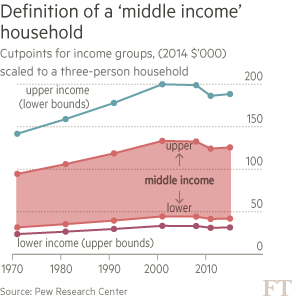
Lowest income Households with less than half the overall median income: less than $31,000 a year in 2015.
Lower-middle income Households from one-half to less than two-thirds the overall median income: between $31,000 to $42,000 a year in 2015.
Middle income Households with an income that is two-thirds to twice overall median income: between $42,000 to $126,000 a year in 2015.
Upper-middle income Households with an income that is between twice and three times overall median income: between $126,000 to $188,000 a year in 2015.
Upper income Households with an income that is more than three times the median, or more than $188,000 a year in 2015.
Letter in response to this article
Trump won’t become president — but I worry about who will follow him / From Dominique Dare
Comments